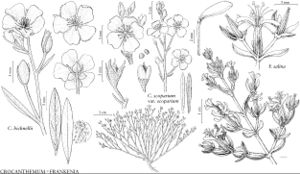FNA>Volume Importer |
FNA>Volume Importer |
||
| Line 17: | Line 17: | ||
|distribution=United States;Mexico;South America;Eurasia;Africa;Atlantic Islands;Australia;introduced in West Indies. | |distribution=United States;Mexico;South America;Eurasia;Africa;Atlantic Islands;Australia;introduced in West Indies. | ||
|discussion=<p>Genus 1, species ca. 70 (5 in the flora).</p><!-- | |discussion=<p>Genus 1, species ca. 70 (5 in the flora).</p><!-- | ||
| − | --><p>Kubitzki (2003b) recognized two genera, Frankenia and Hypericopsis, in Frankeniaceae; molecular evidence supports inclusion of Hypericopsis within Frankenia (J. F. Gaskin et al. 2004). Molecular studies have placed Frankeniaceae and Tamaricaceae, which generally have been recognized as related families, in the Caryophyllales (for example, P. Cuénoud et al. 2002).</p> | + | --><p>Kubitzki (2003b) recognized two genera, <i>Frankenia</i> and Hypericopsis, in Frankeniaceae; molecular evidence supports inclusion of Hypericopsis within <i>Frankenia</i> (J. F. Gaskin et al. 2004). Molecular studies have placed Frankeniaceae and Tamaricaceae, which generally have been recognized as related families, in the Caryophyllales (for example, P. Cuénoud et al. 2002).</p> |
|tables= | |tables= | ||
|references={{Treatment/Reference | |references={{Treatment/Reference | ||
| Line 45: | Line 45: | ||
|publication year= | |publication year= | ||
|special status= | |special status= | ||
| − | |source xml=https://jpend@bitbucket.org/aafc-mbb/fna-data-curation.git/src/ | + | |source xml=https://jpend@bitbucket.org/aafc-mbb/fna-data-curation.git/src/8f726806613d60c220dc4493de13607dd3150896/coarse_grained_fna_xml/V6/V6_775.xml |
}}<!-- | }}<!-- | ||
-->[[Category:Treatment]] | -->[[Category:Treatment]] | ||
Revision as of 17:50, 18 September 2019
Herbs, subshrubs, or shrubs, perennial or, rarely, annual. Stems rounded to noticeably angled. Leaves opposite, simple, petiolate or sessile, with salt glands, estipulate, paired leaves connate basally by membranous, sheathing margins with stiff, white hairs, flattened and appressed to stem; petiole narrow to broad, fleshy to flattened and chartaceous; blade margins entire. Inflorescences solitary flowers or terminal or axillary, simple or compound dichasia (frequently with some monochasial branching), bracteate; bracts [2]4, basally connate (rarely incompletely connate). Flowers bisexual [unisexual]; sepals 4–6[–7], persistent, connate, ribbed; petals 4–6[–7], distinct, clawed basally, limb spreading, scalelike appendage or ligule embryo straight; endosperm present.
Distribution
United States, Mexico, South America, Eurasia, Africa, Atlantic Islands, Australia, introduced in West Indies.
Discussion
Genus 1, species ca. 70 (5 in the flora).
Kubitzki (2003b) recognized two genera, Frankenia and Hypericopsis, in Frankeniaceae; molecular evidence supports inclusion of Hypericopsis within Frankenia (J. F. Gaskin et al. 2004). Molecular studies have placed Frankeniaceae and Tamaricaceae, which generally have been recognized as related families, in the Caryophyllales (for example, P. Cuénoud et al. 2002).
